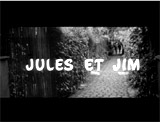
|
Jules and Jim (1962, Fr.) (aka Jules
et Jim)
In Francois Truffaut's acclaimed New Wave romantic
drama, based on Henri-Pierre Roché's semi-autobiographical
novel - about a doomed, dangerous, unconventional, and tragic three-way
love triangle (and "open" or "free love" relationship
between two men and a female) over the course of two decades from
1912 to the early 1930s until the eve of World War II:
- the opening pre-title credits voice-over monologue
(with a black screen), delivered by the film's female protagonist
- a perfectly succinct summary of the film's plot:
- You told me: "I love you."
- I told you: "Wait."
- I almost said: "Yes."
- You said: "Go."
- the unconventional title credits with labels and
images of the principal actors engaged in various activities; and
the innovative cinematic style of the entire film, with haphazard
newsreel footage, intermingled narration and voice-overs, temporal
distortions, wild camera moves, photographic stills, jump-cuts, super-impositions,
wipes, gliding crane shots, collages, tracking and 360 degree circular
shots, and momentary freeze frames
- the 'homosexual' relationship first established between
quiet, shy, calm, naive and blonde conservative Austrian writer Jules
(Oskar Werner), and extroverted, French-born Jim (Henri Serre); and
their holiday in the Adriatic (Greece), where they went to an outdoor
museum after becoming bewitched by a picture of an ancient Greek
sculpture of a female with an alluring, enchanting and mysterious
smile - and the two decided that they wanted to find a doppelganger woman
with the same smile ("They stared at the face for an hour. It
stunned them into silence. They were speechless. Had they ever met
such a smile? No. If they ever met it, they would follow it")
- the love triangle, soon to be established between
the elusive Catherine (Jeanne Moreau) - a free-spirited, liberated,
impulsive French illustrator with the enigmatic smile the two were
looking for, Jules (her eventual husband) and Jim, a returning WWI
soldier
- the famous sequences of their bicycle riding in the
countryside, and their competitive foot-race across a Parisian bridge,
after Catherine (disguised and dressed as a male, with a painted-on
mustache) challenged the two men: "Let's have a race. First
one to the end of the bridge" - she won, although "cheated" by
getting a head-start before the countdown ended; and their threesome
at the beach
|
The Many Scenes of the Threesome: Jules, Jim and
Catherine
|
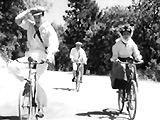
|

|
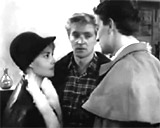
|
|
Riding Bicycles
|
Foot-Race Across Parisian Bridge
|
Always Together
|
- the sequences of the "burning of lies" when
Catherine set fire to a bowl full of her letters, and her dress
accidentally caught fire, and when she threw herself off a bridge
during a mock suicide and was rescued by the two men
- after the intervention of WWI, when the two men fought
on opposite sides of the conflict, Jim reacquainted himself with
Catherine and Jules, who now had a five year-old daughter named Sabine
(Sabine Haudepin) and lived in an Austrian Black Forest area cottage-chalet
nearby the Rhine, but whose marriage was in disrepair, leading to
increased tensions between the threesome
- the romantic scene of Catherine with Jules, discussing
their changing love: Catherine: "We were truly happy."
Jules: "We still are. At least, I am."
Catherine: "Really? We'll always stay together. Like an old couple,
with Sabine and Sabine's children. Hold me close to you."
- the captivating scene of Catherine, in her countryside
home and accompanied by Albert (Serge Rezvani) on guitar, spontaneously
singing the folksy Le Tourbillon de la Vie ("Life's whirlpool
of days") - although mistakenly she inverted two verses and
made a hand gesture acknowledging that she had reversed them: (Chorus: "We
met with a kiss A hit, then a miss It wasn't all bliss And we parted
We went our own ways In life's whirlpool of days")
|
Murder-Suicide Plot Twist Ending
|
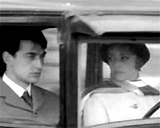
|

|
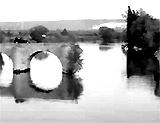
|

|

|
|
- in the shocking twist conclusion, the vascillating
and depressed Catherine decided to end things for herself; after
stopping briefly at an outdoor cafe driving her new motorcar, she
invited Jim to go for a ride while Jules was urged to watch from
afar: ("Watch us, Jules!") - and then she proceeded across
a broken and damaged bridge and straight off its edge - the abrupt
incident was ruled a murder/suicide by police [Note: Some have
suggested that the scene became the inspiration for the suicidal/murder
drive into the Grand Canyon by Thelma & Louise (1991).]
- in the ending, following their deaths, their coffins
were slid into the furnace of a crematorium, and their remaining
bone fragments were crushed into ashes, and inserted into two urns
for interment in separate compartments in a mausoleum, as Jules watched;
afterwards, he departed down the cemetery driveway as the soundtrack
played Catherine's song; the narrator recounted the events: "Jules
would no longer dread, as he had from the beginning, her unfaithfulness
and that he might lose her, since she was gone now. Their bodies
were found in the river. Jim's coffin was huge. It dwarfed Catherine's.
They left nothing of themselves. But Jules had his daughter. Did
Catherine merely seek excitement? No. But she had dazed Jules. He
was overcome with relief. The friendship of Jules and Jim had no
equivalent in love. They enjoyed little things together. They accepted
their differences with tenderness. Everyone called them Don Quixote
and Sancho Panza. The ashes were placed in an urn. Jules might have
mixed them. Catherine wanted hers to be cast to the wind but that
was not permitted"
|


Title Credits
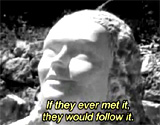
Ancient Greek Sculpture of Female with Beguiling Smile
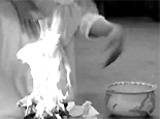
"The Burning of Lies" Scene

Mock Suicide - Throwing Herself Off Bridge
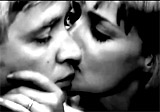
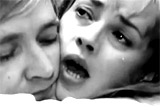
Jules and Catherine - Speaking About Their Changing Love
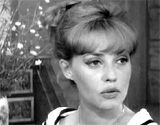
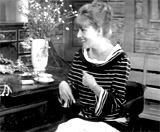
Catherine Singing a Folksong - And Realizing Her Mistake
With a Hand Gesture
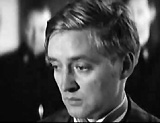
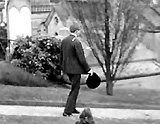
After Catherine's Death, Jules at Crematorium and
at Cemetery
|












